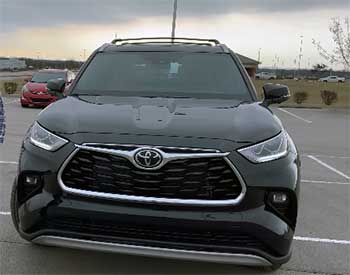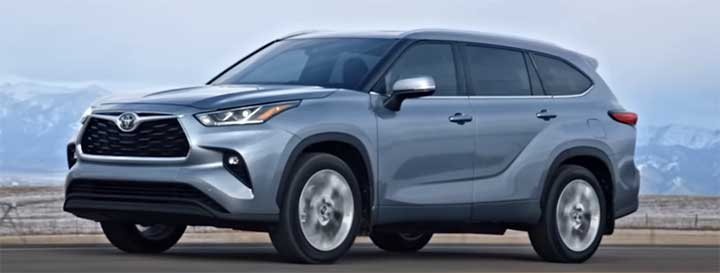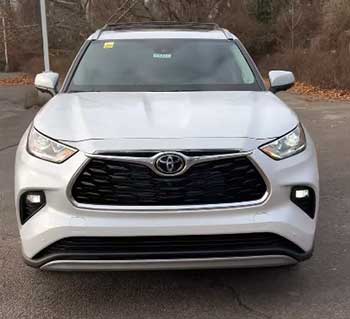
I’ve always been a fan of Toyota’s reliability, so when it came time to consider a three-row SUV for my family’s adventures, the 2025 Toyota Highlander and its hybrid sibling caught my eye.
Both promise space, comfort, and that Toyota dependability, but they cater to slightly different needs. In this article, I’ll walk you through my analysis of the Highlander and Highlander Hybrid, comparing their performance, efficiency, features, and costs to help you decide which fits your lifestyle.
From city commutes to weekend getaways, I’ll break down what makes each model shine and where they fall short.
Comparison Table: Toyota Highlander Vs. Highlander Hybrid
| Feature | Toyota Highlander | Toyota Highlander Hybrid |
|---|---|---|
| Base Price | $39,520 | $46,020 |
| Powertrain | 2.4L turbo 4-cylinder, 265 hp | 2.5L 4-cylinder + electric motors, 243 hp |
| Fuel Economy | 22 city/29 highway MPG | 36 city/35 highway MPG |
| Drivetrain | FWD or AWD (add $1,600) | Standard AWD |
| Towing Capacity | 5,000 lbs | 3,500 lbs (Hybrid MAX: 5,000 lbs) |
| Seating | Up to 8 | Up to 8 |
| Cargo Space | 16/48.4/84.3 cu. ft. | 16/48.4/84.3 cu. ft. |
| Warranty | 3-yr/36,000-mile basic, 5-yr/60,000-mile powertrain | Same + 8-yr/100,000-mile hybrid system |
| Reliability (J.D. Power) | 81/100 | 81/100 |
| Safety (NHTSA) | 5-star overall | 5-star overall |
My Experience With The Toyota Highlander
Driving the 2025 Toyota Highlander feels like slipping into a well-worn pair of sneakers—comfortable, reliable, and ready for anything. Its 2.4-liter turbocharged four-cylinder engine pumps out 265 horsepower, giving it a bit more pep than the hybrid. I took it on a weekend trip with my family, and the smooth eight-speed automatic transmission made highway cruising effortless.
The cabin is spacious, with enough room for my kids to stretch out in the second row, though the third row is best for smaller passengers. The infotainment system, with its available 12.3-inch touchscreen, was intuitive, and Apple CarPlay kept everyone entertained.
However, I noticed the gas Highlander’s fuel economy—22 city/29 highway MPG—wasn’t stellar for daily commutes. It’s a solid choice for those who prioritize power, especially if you’re towing a trailer (up to 5,000 pounds).
The ride is stable, but it’s not exactly thrilling; it’s built for family duties, not spirited drives. I appreciated the standard safety features like automatic emergency braking and lane-keep assist, which gave me peace of mind with my kids in the back.
Pros Of The Toyota Highlander
- Stronger Engine Output: The 265-horsepower turbo engine delivers more raw power than the hybrid’s 243 hp, making it better for towing or quick acceleration on highways. It feels punchier when merging or passing.
- Lower Starting Price: At $39,520, it’s more budget-friendly than the hybrid’s $46,020 starting point. For cost-conscious buyers, this price gap can be significant.
- Flexible Drivetrain Options: You can choose front-wheel drive to save on cost or opt for all-wheel drive for better traction. This flexibility suits varied driving conditions.
- Towing Capacity: With a 5,000-pound towing capacity across all trims, it’s ideal for hauling small boats or campers, outperforming the standard hybrid’s 3,500 pounds.
- Spacious Cabin: The interior offers ample room for up to eight passengers, with 84.3 cubic feet of cargo space when the rear seats are folded. It’s practical for family road trips.
- Reliable Reputation: Both models score 81/100 on J.D. Power’s reliability scale, but the gas model’s simpler powertrain may appeal to those wary of hybrid complexity.
The gas Highlander’s strengths lie in its affordability and power. I found it particularly appealing for long drives where I needed to tow our small trailer or carry extra gear. The lower price point meant I could opt for a higher trim, like the XSE, with sport-tuned suspension for a slightly sharper ride. The cabin’s soft-touch materials and straightforward controls made it feel welcoming, and the option to skip AWD saved me some cash upfront.

Cons Of The Toyota Highlander
- Mediocre Fuel Economy: The 22/29 MPG city/highway rating lags behind competitors like the Honda Pilot (up to 27 MPG highway). Frequent commuters may feel the pinch at the pump.
- Cramped Third Row: The third row is tight, better suited for kids than adults. My teenagers complained about legroom on longer trips.
- Less Responsive Handling: While stable, the Highlander isn’t fun to drive. It feels heavy in corners, and the steering lacks feedback compared to a Mazda CX-90.
- Higher Fuel Costs: Over time, the gas model’s lower efficiency means higher fuel expenses, especially with rising gas prices. I spent more on fill-ups than I expected.
- Limited Electric-Only Capability: Unlike the hybrid, there’s no electric mode for short, low-speed drives, missing out on potential fuel savings in city traffic.
The gas Highlander’s fuel economy was a noticeable drawback during my daily commutes. I also found the third row impractical for anything beyond short trips with younger kids. While the power was nice, the lack of agility made it less engaging on twisty roads, and I wished for the hybrid’s fuel-saving tricks in stop-and-go traffic.
Read more: My Thoughts on Honda Odyssey Vs. Subaru Ascent
Maintenance Tips For The Toyota Highlander
- Regular Oil Changes: Change the engine oil every 7,500–10,000 miles to keep the turbocharged engine running smoothly. I stick to synthetic oil for better performance.
- Tire Rotations: Rotate tires every 6,000 miles to ensure even wear, especially if you opt for AWD. This saved me from uneven tread on long trips.
- Brake Inspections: Check brakes every 15,000 miles, as the Highlander’s weight can stress pads. I caught a worn pad early, avoiding costly rotor damage.
- Air Filter Replacement: Replace the engine air filter every 30,000 miles to maintain fuel efficiency. A clogged filter hurt my MPG on one trip.
- Coolant Checks: Inspect coolant levels annually to protect the turbo engine from overheating. I top off with Toyota’s recommended coolant for longevity.
- Battery Maintenance: Check the 12-volt battery every two years, as turbo engines demand more power. A weak battery once left me stranded.
Maintaining the gas Highlander is straightforward, but the turbo engine requires diligence. I learned to keep a close eye on oil levels after noticing slight performance dips when I delayed changes. Tire rotations made a big difference in handling, especially on wet roads with AWD. Regular brake checks are a must, as the SUV’s heft can wear them down faster than expected.
My Experience With The Toyota Highlander Hybrid
The 2025 Toyota Highlander Hybrid won me over with its efficiency. Its 2.5-liter four-cylinder engine, paired with electric motors, delivers 243 horsepower and a stellar 36 city/35 highway MPG. I tested it on a mix of city errands and a coastal road trip, and the fuel savings were noticeable—fewer gas station stops meant more time enjoying the drive.
The standard AWD provided great traction on wet roads, and the cabin matched the gas model’s comfort, with plush seats and a quiet ride. The hybrid’s regenerative braking felt smooth, recharging the battery seamlessly.
However, the hybrid’s higher starting price ($46,020) gave me pause, and the 3,500-pound towing capacity (unless you upgrade to Hybrid MAX) limited its utility for heavier loads. The third row, like the gas model, felt cramped. Still, the electric-only EV mode was a game-changer for short, silent drives around town, and the safety suite, including adaptive cruise control, made highway trips stress-free.
Pros Of The Toyota Highlander Hybrid

- Outstanding Fuel Economy: The 36/35 MPG rating is a standout, saving me hundreds annually on fuel compared to the gas model. It’s perfect for city commuters.
- Standard All-Wheel Drive: AWD comes standard, enhancing traction without extra cost. I felt confident driving through rain-soaked streets.
- Smooth Power Delivery: The hybrid’s electric motors provide instant torque, making stop-and-go traffic feel effortless. It’s surprisingly responsive.
- Extended Hybrid Warranty: An 8-year/100,000-mile hybrid system warranty (10-year/150,000 in some states) adds peace of mind. I worry less about battery issues.
- Eco-Friendly Appeal: Lower emissions and electric-only mode make it a greener choice. I felt good reducing my carbon footprint on daily drives.
- Quiet Ride: The hybrid’s electric assist keeps the cabin quieter than the gas model, especially at low speeds. It’s a serene experience.
The Highlander Hybrid’s efficiency was a revelation. I saved about $800 a year on gas compared to the gas model, and the quiet cabin made school drop-offs peaceful. The standard AWD was a bonus, handling slick roads with ease. The hybrid’s smooth acceleration and eco-friendly vibe aligned perfectly with my desire for a practical yet sustainable family SUV.
Cons Of The Toyota Highlander Hybrid
- Higher Upfront Cost: Starting at $46,020, it’s pricier than the gas model. The cost difference took some justifying for my budget.
- Lower Towing Capacity: The standard hybrid tows only 3,500 pounds, less than the gas model’s 5,000. I couldn’t tow our camper without upgrading.
- Slightly Less Power: With 243 hp, it’s less potent than the gas model’s 265 hp. Highway passing felt a bit sluggish at times.
- Third-Row Tightness: Like the gas model, the third row is cramped, unsuitable for adults on long trips. My teens were uncomfortable back there.
- Battery Maintenance Concerns: Though rare, hybrid battery replacement can be costly post-warranty. I worried about long-term expenses.
The hybrid’s price tag was a hurdle, and the lower towing capacity meant I had to rethink some camping plans. The third row’s lack of space was a letdown, and while the hybrid system is reliable, the thought of future battery costs lingered in my mind.
Maintenance Tips For The Toyota Highlander Hybrid
- Hybrid Battery Checks: Have the hybrid battery inspected every 15,000 miles to ensure optimal performance. I caught a minor issue early this way.
- Regenerative Brake Maintenance: Check brake pads every 20,000 miles, as regenerative braking reduces wear but doesn’t eliminate it. I extended pad life with regular checks.
- Coolant for Hybrid System: Use Toyota’s hybrid-specific coolant and check levels annually. This kept my system running efficiently.
- Tire Rotations: Rotate tires every 6,000 miles to maintain AWD performance. Uneven wear affected my traction once.
- Air Filter Replacement: Replace cabin and engine air filters every 30,000 miles for efficiency. A clean filter boosted my MPG.
- Software Updates: Ensure the hybrid system’s software is updated during service visits. A free update improved my fuel economy slightly.
The hybrid’s maintenance is similar to the gas model but with extra attention to the battery and cooling system. I found that staying proactive with tire rotations and filter changes kept the SUV running like new. Software updates at the dealer were a nice touch, optimizing the hybrid system’s performance.
Comparison With Other Brands
- Honda Pilot: The Pilot offers more third-row space and a 285-hp V6, but its 19/27 MPG lags behind the Highlander Hybrid. I found it less efficient for daily drives.
- Kia Telluride: The Telluride boasts a premium interior and 5,000-pound towing, matching the gas Highlander. Its 20/26 MPG can’t compete with the hybrid’s efficiency.
- Hyundai Santa Fe Hybrid: With 34 MPG combined, it’s close to the Highlander Hybrid but starts cheaper at $36,950. I noticed its interior felt less refined.
- Mazda CX-90: The CX-90’s sporty handling outshines both Highlanders, but its 24/28 MPG and higher price ($48,900) made it less practical for me.
- Nissan Pathfinder: The Pathfinder’s V6 tows up to 6,000 pounds, beating both Highlanders. Its 20/27 MPG and less polished cabin didn’t impress me as much.
The Highlander and Highlander Hybrid hold their own against competitors. The Pilot and Telluride offer more space or luxury, but the hybrid’s fuel economy is unmatched in its class. The Santa Fe Hybrid is a budget-friendly rival, but I preferred Toyota’s reliability. The CX-90 is fun but pricey, and the Pathfinder’s towing edge comes at the cost of efficiency.
Read more: My Thoughts on GMC Terrain Vs. Ford Escape
Frequently Asked Questions (Faq)
The hybrid uses a 2.5L engine with electric motors (243 hp) and gets 36/35 MPG, while the regular Highlander has a 2.4L turbo engine (265 hp) with 22/29 MPG. The hybrid has standard AWD; the gas model offers FWD or AWD.
It depends on your priorities. The hybrid’s $6,500 higher price is offset by fuel savings ($700–$1,000/year) and standard AWD, making it worth it for frequent drivers.
It’s a Highlander with a gas-electric powertrain, combining a 2.5L engine with electric motors for better fuel efficiency and lower emissions. It can run on electric power at low speeds.
Yes, it’s EPA-rated at 36 city/35 highway MPG. In my testing, I consistently hit 34–36 MPG in mixed driving, especially in city conditions.
Conclusion: For Your Family Suv Needs
You’re probably wondering which Highlander is right for you, and I get it—it’s a big decision. If you’re after power, towing capability, and a lower upfront cost, the gas Highlander is a solid pick. It’s reliable, spacious, and ready for family adventures, though its fuel economy might sting over time.
If saving on gas and driving greener are your goals, the Highlander Hybrid’s efficiency and standard AWD make it a compelling choice, despite the higher price. Both are fantastic SUVs, but your choice hinges on whether you value power or efficiency more. What’s your priority?

